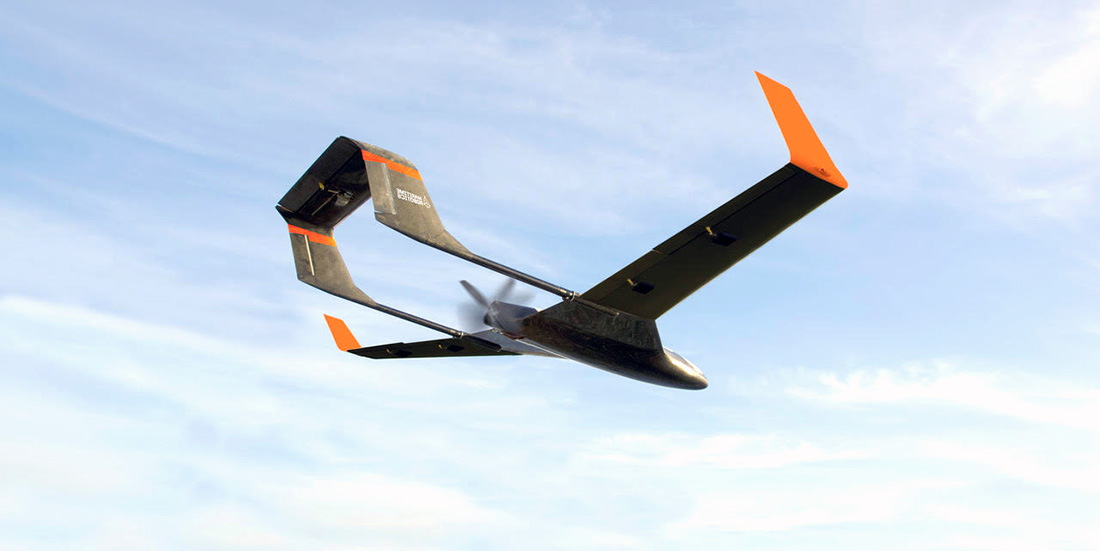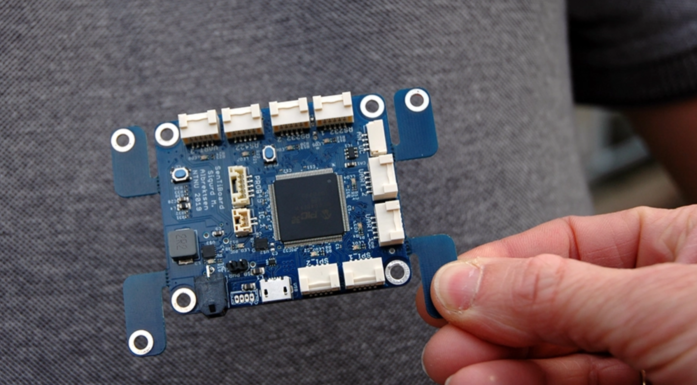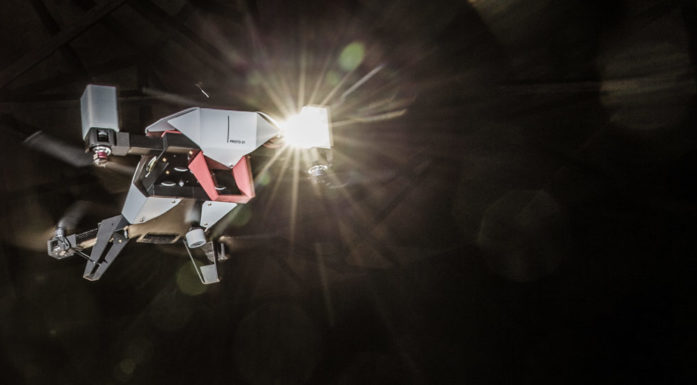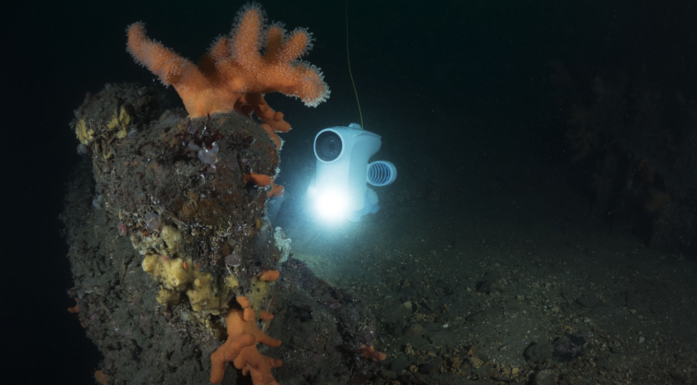Drones catching drones
How do you catch a drone flying at 70 km/h over a ship? With string.
Most of the little drones we’re familiar with look like a small helicopter. They are controlled remotely and can land anywhere. But most drones that are used professionally for surveillance, inspection, mapping, exploration and other offshore missions have fixed wings, are self-guided and need a small airstrip.
The problem is that a lot of ships don’t have the space required to land. If the weather is bad, landing on ships is always difficult.
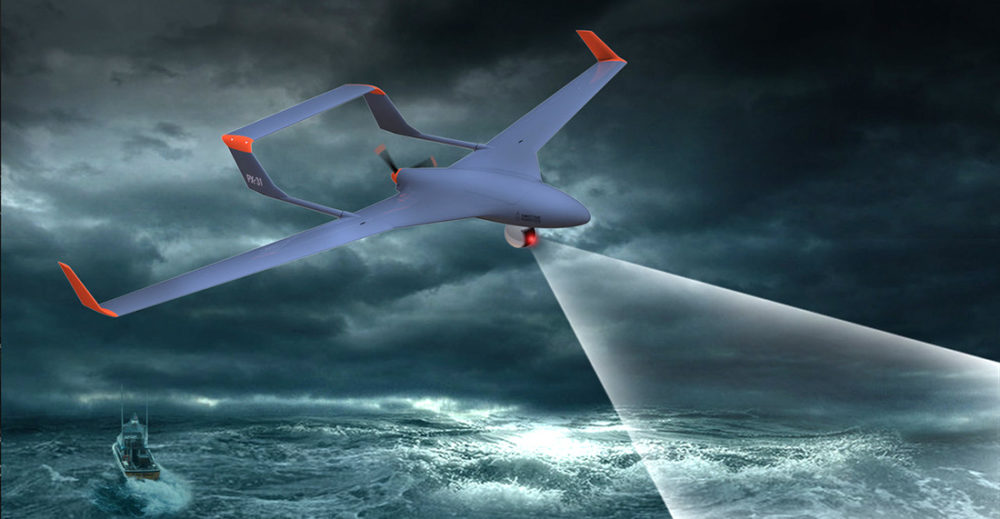
NTNU has developed a new method to capture drones while the drones are in flight. The method can be used on ships, oil platforms and other places where fixed wing drones can’t land. The advantage of this type of drone is that they have greater range and can carry more cargo than multicopters, the “helicopter drones” that have multiple rotors. Illustration: Maritime Robotics AS
Mid-air arrest
Several solutions exist for catching fixed-wing drones from ships, but researchers at NTNU’s Department of Engineering Cybernetics believe their method is superior. Two autonomous multicopters take off from the ship with a cable between them, and align themselves with the fixed-wing drone’s position and planned path. By stretching the cable between them on the same course as the approaching drone, and slightly lower, they create a line that can be used to hook the drone.
Caught at full speed
As the fixed-wing drone approaches, a small box opens on the underside of its fuselage and a catch line drops with a hook on the end. Before the catch line and the cable come into contact, the multicopters begin to fly in the same direction as the fixed-wing drone to reduce the energy of braking. The hook catches the arresting cable, the drone loses speed and ends up hanging from the arresting cable before the autonomous multicopters manoeuvre it down onto the ship’s deck. If the drone isn’t successfully captured by the arresting cable, it is programmed to turn and retry, without anyone having to take over with remote control steering.
Article continues below video.
Launching fixed-wing drones from ships is easier using different types of catapults. Video: Mads Bornebusch, NTNU
Well suited for Norway
Professor Tor Arne Johansen at NTNU’s Department of Engineering Cybernetics believes there is great potential for autonomous drones.
“Unmanned, autonomous drones are often portrayed as one of the technologies with the greatest potential in international assessments. This applies especially in Norway, which has rugged geography, great natural resources, high costs and extensive expertise. The technology can reduce the cost of data acquisition, reduce risks and provide important decision-making support for many different purposes,” says Johansen.
How great is the need to land drones offshore?
“The difficulty of operating drones from ships is currently the biggest obstacle to using more autonomous drones offshore. New methods that enable efficient and safe take-offs and landings from ships would open up a wide range of new applications.”
What is the advantage of NTNU’s “line catch” method?
“The operation can be performed virtually anywhere, without a runway or other infrastructure. The method requires minimal modifications to any fixed-wing drone, as opposed to more traditional methods that recover fixed-wing drones in nets or vertical lines. These require the drone to be designed to withstand the heavy loads encountered during landings.”
Can tolerate bad weather
The catch method is scalable, says Johansen. If the drone is big and flies at high speed, you need to use a strong, long cable and make sure the multicopters can fly fast in the same direction for less abrupt braking. This is impossible with landing systems mounted on ships, he says.
NTNU’s drone recovery solution can be used in bad weather because with long lines you don’t need as accurate a position as other methods. However, the most common fixed-wing drones today aren’t able to fly in winds over 10 metres per second, and they can’t withstand icing and heavy rainfall. NTNU is conducting research on systems and fixed-wing drones that will be able to operate in rougher weather.
Just as with large military aircraft with fixed wings that can take off and land vertically (VTOL, vertical take-off and landing), some autonomous drones can do the same. The disadvantage is that these drones have a shorter range and are more complex.
Betting on autonomous crafts
The development of drone recovery systems is only a small part of NTNU’s involvement in autonomous vessels. AMOS, one of NTNU’s centres of excellence, is a driving force in the research on autonomous marine operations and systems. At any one time, the programme engages approximately 100 researchers working with autonomous surface and underwater vessels, drones and small satellites.
EU support
The drone recovery trials were conducted at Eggemoen airport in Hønefoss in November 2018. The project has received support from the Research Council of Norway and the EU Horizon 2020 programme. The Norwegian company Maritime Robotics is a partner in the project and has signed an agreement with NTNU and NTNU Technology Transfer for the licensing of the technology.
Professor Tor Arne Johansen is responsible for the project, Mads Friis Bornebusch led the testing at Eggemoen and PhD candidate Martin Lysvand Sollie is continuing research on the technology.
